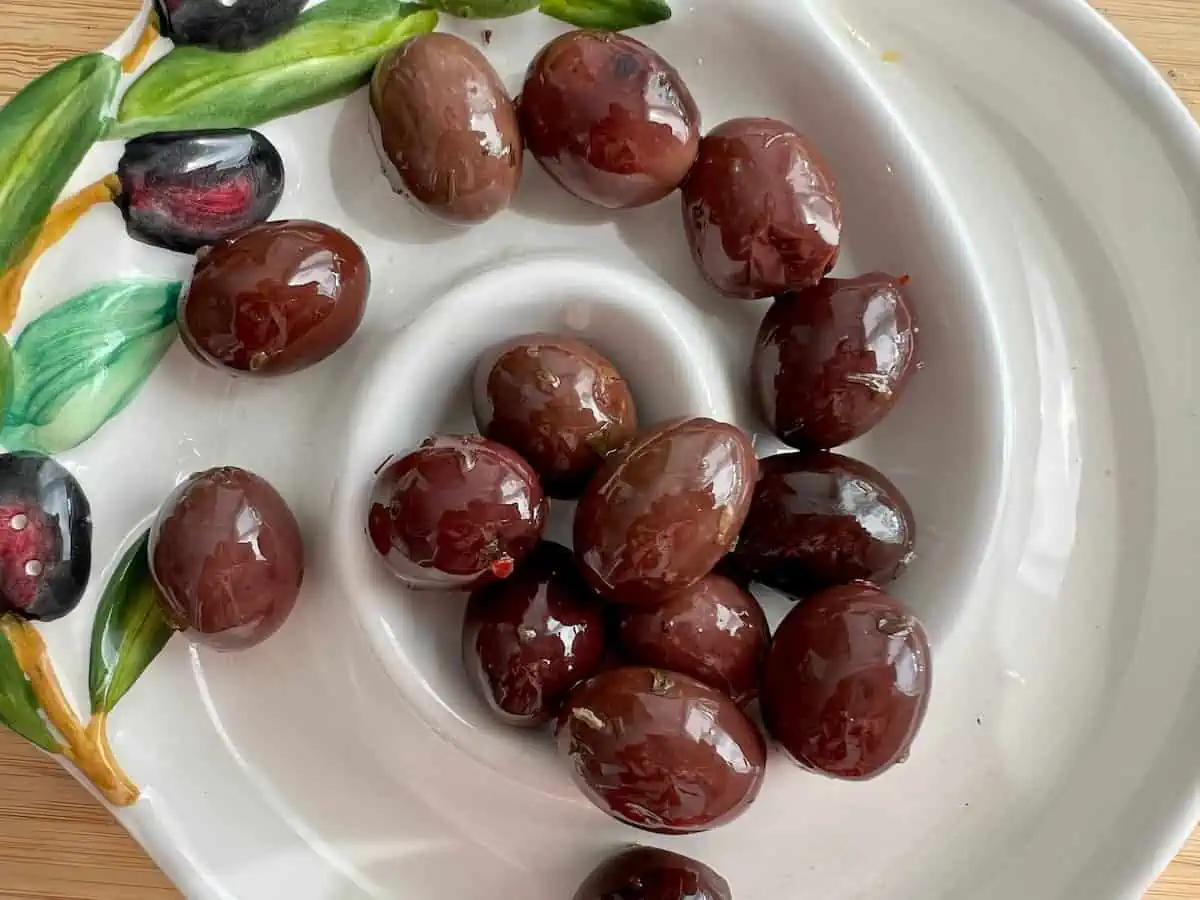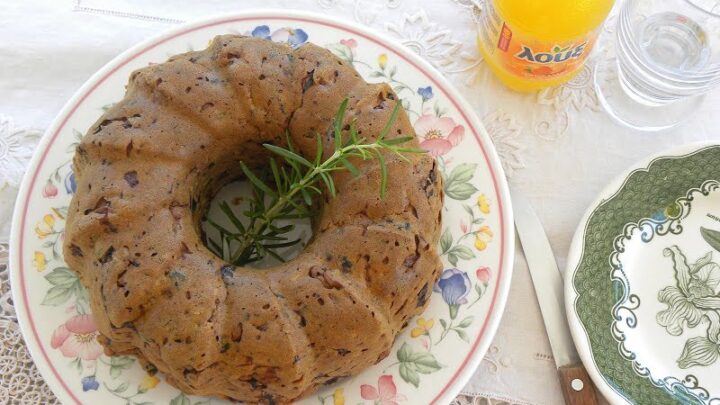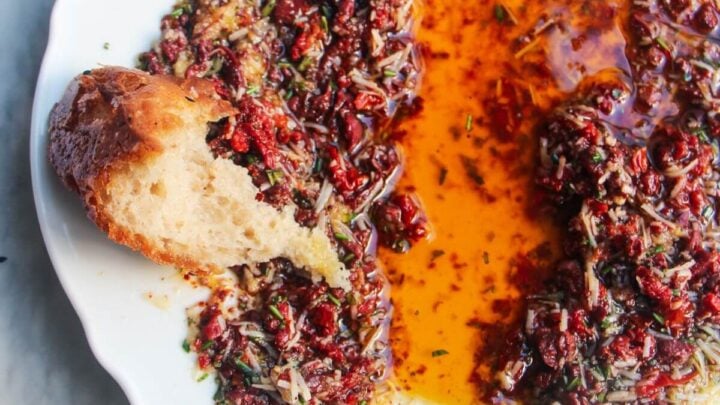We may earn income from links in this post. Please read this Disclosure for details.
Kalamata olives are beloved around the world. Although they’re often served straight from the brine as an appetizer, it’s also possible to cook with them with delicious results.
From party-ready olive tapenade to one-pot pastas perfect for a quick family dinner, there are many ways to showcase the fabulous flavour of these tasty (and good for you!) Greek treasures.
You’ll find lots of inspiration in this collection of delicious kalamata olive recipes for appetizers, entrees, sides and even dessert!
And of course, there’s a perfect recipe for classic Greek village salad.

Jump to:
What Are Kalamata Olives?

An important part of the healthy Mediterranean diet, table olives are one of the world’s oldest fermented foods.
Along with Spain and Italy, Greece is one of the largest producers of table olives.
It’s also the birthplace of the Kalamata olive.
I just returned from almost two months exploring the city of Kalamata and the Peloponnese region of Greece.
After visiting the olive oil museum in Sparta, taking cooking classes and meeting with olive producers, I can tell you that not every black olive is a Kalamata olive!

The Kalamon or Kalamata olive is harvested from a specific olive tree varietal of the same name, the Kalamon.
It’s from this olive tree variety that producers harvest and produce the famous Kalamon or Kalamata table olives found in stores, delicatessens and restaurants around the world.

How Kalamata Olives Are Made
The first thing I learned in the Peloponnese region of Greece is that olives can’t be eaten directly from the tree!
Don’t expect to go wandering around an olive grove snacking on olives like from a charcuterie board.

Although they’re a fruit, olives are unpalatable raw. They must be treated by curing and fermentation to reduce the bitterness which comes from a compound called oleuropein.
The fermentation process also adds healthy probiotics and gut-healthy bacteria to the olives which contain daily values of dietary fibers, fatty acids and antioxidants.
During a gastronomy walking tour with Maria Monastirioti of Mama’s Flavours, we stopped in at Trofopoleion 51, one of the oldest olive oil shops in Kalamata.
In addition to getting a tutoured tasting of extra virgin olive oil, we learned about table olives.

During our visit, co-owner Kely Koutelas explained how people prepare Kalamata table olives using traditional methods and pure, simple ingredients.
Olive processing begins as soon as the fruit ripens between November and December. Kalamata olives intended for the table (rather than oil) are harvested by hand or mechanically when they’re almost mature but not over-ripe.
The producer makes a superficial cut on each olive with a razor. The cut helps the olive absorb the brine and flavours of the dried herbs that will be added later.
Then, they place the olives in a pot and cover them with water to soak.
The water is changed every 2 days for 15-20 days. Then, they strain the olives, sprinkle them with coarse sea salt and leave them in a vessel for 1-2 days, stirring occasionally.

After they’ve soaked in salt, a high-acidity homemade vinegar is added and the olives are left to marinate for 24 hours.
Finally, when the fermentation process is complete the olives are packed in clean glass or clay jars. Dried herbs like thyme, rosemary, oregano and/or dried orange peels and garlic cloves can be added.
🌟 Fun Fact: Unliked Spanish olives which are produced by lye curing, with Greek olives the bitter oleuropein compound is removed by enzymes produced by fermentation.
Choosing the Best Kalamata Olives

The International Olive Council (IOC), an international intergovernmental organization, recommends standards for the characteristics of olive oils and table olives.
This complex set of chemical and sensory tests can take decades to learn!
According to a research study of table olives by the Faculty of Bioscience at the University of Teramo, an over production of yeast produced during fermentation can cause softening of the olive tissue.
Creating a quality product begins at harvest. Kalamata table olives are selected for their high flesh-to-stone ratio, fine flesh and ease of detachment from the stone.
Curing the olives also shapes their flavour, texture, appearance. When shopping for the kalamata olives to use in a recipe, look for olives that:
- elongated in shape
- firm in texture, not mushy.
- free of added preservatives.
- don’t have cloudy brine.
- have no off odor.
- if wrapped in plastic, the package should not be bulging.
Nutrition

Several studies have shown that fermented Kalamata table olives are beneficial as a probiotic food. They’re rich in bioactive molecules with nutritional, antioxidant and anti-inflammatory properties.
In addition to their health-promoting bioactive compounds, Kalamata olives are an excellent natural source of unsaturated fatty acids including oleic, linoleic and palmitic acids.
No wonder they’re an important part of the Mediterranean diet.
In Greece, Cyprus, Italy and Spain, you’ll see olives served at most traditional meals, including breakfast!
Should Olives Be Pitted or Unpitted?

The quality (especially the texture) of a kalamata table olive begins to deteriorate as soon as it’s pitted.
The flesh begins to absorb liquid, becomes mushy and loses its savoury flavour. It also becomes saltier.
If being eaten straight from the brine as an appetizer or a salad, Kalamata olives are generally served with the pits inside.

Most recipes will specify whether the olives should be pitted or not. Most often they will need to be pitted, especially if being served to people who are unfamiliar with eating olives.
It’s best to pit the olives yourself rather than buy unpitted olives in a jar.
How to Pit a Kalamata Black Olive

The good news is that because of the way they are produced, it’s relatively easy to pit a Kalamata olive.
Begin with an olive at room temperature. Then, place the whole olive on a cutting board and press down on it with the flat of a large chef’s knife.
The olive will split and you can easily slip out the pit and discard it. Then prepare the olive flesh according to the Kalamata olive recipe you’re using and chop it, put it into a food processor or use it as is.
19 Delicious Kalamata Olives Recipes
The Best Baked Feta Recipe
This versatile recipe for Baked Feta does double duty as a delicious appetizer or as a side dish! Serve it with crusty bread or as a side for grilled meats, veggies or pasta. The creamy feta, briny kalamata olives and fragrant herbs such as fresh oregano make it irresistible.
Kalamata Olive Tapenade
This Kalamata Olive Tapenade is one of the most popular appetizers ever! Whip it up with a food processor in no time at all. Made with fresh garlic cloves, anchovy paste, and lemon juice, just watch it disappear. Perfect on crostini!
Easy Pizza Pasta Salad
Perfect for summer entertaining and picnics, this easy pizza pasta salad is ready in minutes and can be made it advance. Kids especially love the mix of flavours. This filling salad also travels exceptionally well so makes a great boating meal or snack.
Kalamata olive hummus with artichokes
This kalamata olive hummus pops with briny flavour. Serve with warmed pita bread for dipping for the ultimate easy to make appetizer for your next dinner party.
Spaghetti alla Puttanesca
Ready in just 15 minutes spaghetti alla puttanesca is a delicious weeknight meal. But it's special enough for entertaining! The tasty combination of Greek olives, capers, anchovies and fresh tomatoes makes this dish a classic among Kalamata olives recipes.
Greek Spaghetti
This easy pasta dish, Greek spaghetti, features Kalamata olives, cherry tomatoes, and feta cheese tossed with a tasty vinegar dressing. The simple wholesome ingredients make this a great summer dinner choice.
Mediterranean Baked Fish with Artichokes and Olives
This Mediterranean Baked Fish with Artichokes and Kalamata olives is an easy, fast, and incredibly healthy dinner. It's perfect for any night of the week or for entertaining.
Traditional Greek Salad Recipe - Horiatiki Salata
This classic recipe for Greek Village Salad makes the handy side dish for grilled chicken, beef and lamb. It features an authentic Greek vinaigrette that showcases the delicious sweetness of fresh tomatoes paired with salty feta and Kalamata olives.
Chicken with Olives and Artichokes
This chicken and Kalamata olive skillet dinner is easy enough for a weekday meal but special enough for entertaining. It''s made in one pan so clean-up is a breeze. You'll love the Mediterranean flavours.
Mediterranean Chicken Thighs
Easy Roasted Mediterranean Chicken Thighs with tomatoes and olives is a one pan meal with both a main and side dish cooked together. It features both Kalamata and green olives, chicken thighs, balsamic vinegar, lemon, herbs and feta baked to perfection.
Mediterranean Chickpea Salad with Kalamata Olive Salad Dressing
Lemon-infused Kalamata olive dressing adds a boost of Mediterranean flavour to this crunchy chickpea salad. Fresh, crisp and super portable, it's the ideal summer salad for potlucks, boating lunches and picnics.
Greek Pita Pizza
Put a Mediterranean twist on pizza night with Greek Pita Pizza! Top yours with ground lamb, Kalamata olives, feta, pickled red onion, and arugula for an easy yet satisfying meal the whole family will love.
Kalamata Olive Spread
For the olive lover in you, try this New Orleans muffuletta-style Kalamata Olive Spread. It's great for sandwiches or on the side for picnics, summer meals and boating trips.
Elioti Cake (Tahini and Olives Cake)
Elioti Cake is a unique vegan savory cake made with black olives and tahini. Tahini is the only fat in the recipe and along with herbs, spices and orange juice it's a healthy and nutritious option.
Vegan Mediterranean Lemon Olive Couscous
This easy Mediterranean Lemon Olive Couscous is ideal for summer entertaining and lunches to go. The fresh flavours of lemon, oregano, parsley and Greek olives make it a popular side dish for summer BBQs and potlucks, It's also vegetarian and vegan too! .
Olive Bread with Rosemary
This Kalamata olive bread with rosemary is a fabulous bread for any olive lover. Aromatic and delicious, you can make this in a bread machine or bake in your oven.
Cheesy Tomato One Pot Orzo Risotto (Orzotto)
This super easy tomato orzo risotto (or orzotto!) takes just 20 minutes to make. It's packed with flavour (hello Kalamata olives and sundried tomatoes) and made all in one pot for the ultimate quick weeknight meal.
Loaded Olive Oil Dip for Bread
A loaded olive oil dip is the easiest appetiser idea for entertaining. Just mix a pile of gorgeous ingredients (think Kalamata olives, parmesan, garlic and herbs) with olive oil and serve with soft, warm bread for the ultimate crowd-pleaser
Greek Orzo Salad
In this delicious and satisfying salad, orzo pasta, chickpeas, fresh tomatoes, veggies, herbs and Kalamata olives get tossed in a homemade vinaigrette. The result is a hearty salad packed with protein and flavour.
Storage and Food Safety
If you’ve enjoyed the salty, briny flavour of these tasty Greek morsels in these kalamata olives recipes, you’ll want to keep a supply on hand for easy meal planning.
How long do olives keep without going bad?
According to food safety research, table olives along with other fermented or acidified vegetable foods (such as pickles and sauerkraut) have a long history of microbial safety due to salt concentration, acidity and other inhibatory compounds.
But that doesn’t mean that olives can’t go bad or harbour food borne bacteria.
In Greece, brined kalamata olives prepared in a traditional way and stored in a dark place away from the heat would be good for 12-18 months.

However, outside Greece, most of us purchase Kalamata olives in the grocery store or delicatessen in jars or at a salad bar.
An opened jar of olives if stored in the refrigerator will be good for up to six months. Olives purchased from a deli display case are good for 3-4 days if stored in brine, covered in the refrigerator.
Health Canada guidelines say avoid purchasing or using cans that are damaged or bulging. Contents could be contaminated and may not be safe to eat.
As always, when in doubt, throw it out.
FAQs
Kalamata olives can be eaten without any special preparation. They should just be drained from the brine and served at room temperature. They don’t need to be rinsed.
Kalamata olives can be used as an appetizer, a snack or in recipes for tapenade spread, olive bread, Greek salad and dips. They’re a very versatile table olive.
The briny, salty flavour of Kalmata olives pairs well with herbs such as oregano and thyme, garlic, fruits such as lemon and orange as well as mild vegetables such as green pepper and cucumber. Creamy cheeses such as feta and gruyere also complement its intensity.
Other Popular Recipe Collections
Messinian Salad
Ingredients
- 1 orange sweet
- 8 ounces syglino (or pasto) smoked pork
- 1/2 cup Kalamata olives pitted
- 1 green onion
- 2 Tbsp extra virgin olive oil Greek
- 1/2 tsp balsamic vinegar
- 1/8 tsp sea salt
Instructions
- Peel, segment and chop one orange into bite-sized pieces.
- Remove ends and slice green onion thinly.
- Slice chilled siglino into large, bite-sized pieces.
- Whisk olive oil and balsamic vinegar together. Add salt.
- Combine orange pieces, siglino, green onion and kalamata olives in a bowl. Pour dressing overtop and mix lightly.
- Serve immediately.
Notes
- figs,
- black Korinthian raisins,
- Sfela cheese (similar to feta but spicier. It’s known as fire cheese),
- boiled potatoes,
- aromatic greens,
- hard cooked eggs,
- halangia (fried ribbons of dough).
Nutrition
Save to Pinterest!


Dividing her time between Canada, Guatemala and Mexico (or the nearest tropical beach), Michele Peterson is the founder of A Taste for Travel. Her award-winning travel and food writing has appeared in Lonely Planet’s cookbook Mexico: From the Source, National Geographic Traveler, Fodor’s and 100+ other publications.
Read more about Michele Peterson.


























 Mediterranean Pizza Pasta Salad
Mediterranean Pizza Pasta Salad